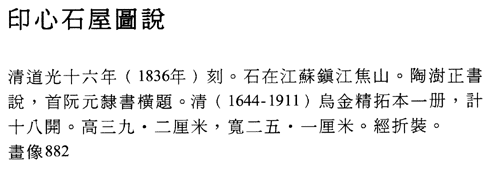 |
|
|
 |
|
|
Illustrations and
Records of the Yinxin Stone Dwellings Qing
dynasty (1644�1911), Daoguang period (1821�50), dated and engraved 1836 Illustrator(s)
unknown; texts by Tao Shu (1778�1839; jinshi of 1802) Album
of 36 leaves (18 double leaves), ink rubbed on paper, accordion-style mounting;
each leaf: approx. 39.2 x 25.1 cm Date
of rubbing not given, probably late Qing dynasty (1644�1911), between 1836 and
1911 Inventory number: Huaxiang 882 In
1835, when he was governor-general at Nanjing, Tao Shu was presented with a
plaque with four large characters in the calligraphy of the Daoguang emperor
(r. 1821�50) which read "Yinxin Stone Dwelling."� Tao Shu adopted this name for his study; it
was also given to structures at a variety of historical sites and scenic spots
that he visited in the course of his governorship of Jiangsu province between
1825 and 1830. The album has a frontispiece by Ruan Yuan (1764�1849), the governor of Zhejiang and a major early-nineteenth-century reformer.� This is followed by four illustrations showing the location of pavilions bearing the name Yinxin Stone Dwelling in the cities of Nanjing, Suzhou, Yangzhou, and Qingjiang or their environs.� Each picture, identified by a title written horizontally in clerical script, takes up two full leaves; each has an accompanying descriptive text engraved in neat columns of small regular script.� The album features a special technique of making rubbings from engraved stones: the so-called wujin ta, black gold rubbings made with lustrous black ink on thick paper and burnished with a polishing shell.� The very fine quality of the resultant rubbings enhance the carefully detailed drawings as well as the expert engraving of the designs on stone slabs. |
 |